History
 I was looking at some of my uncle, Bill Spencer’s family history information yesterday, and I came across a comment he made about some of the pictures. It was about the National Youth Administration that was transferred to the War Manpower Commission in 1941. When he mentioned that it was about educating the nation’s youth, I immediately got on the defensive, because I thought that it almost sounded like the Nazis pulling children out of their homes to train them the way the government wanted them to be trained. Of course, that couldn’t be further from the truth. In reality, and had I read the rest of Uncle Bill’s comments before I got touchy about it, I would have known that. I think sometimes, we have a preconceived idea about things, and we don’t really understand exactly what is going on before we fly off the handle.
I was looking at some of my uncle, Bill Spencer’s family history information yesterday, and I came across a comment he made about some of the pictures. It was about the National Youth Administration that was transferred to the War Manpower Commission in 1941. When he mentioned that it was about educating the nation’s youth, I immediately got on the defensive, because I thought that it almost sounded like the Nazis pulling children out of their homes to train them the way the government wanted them to be trained. Of course, that couldn’t be further from the truth. In reality, and had I read the rest of Uncle Bill’s comments before I got touchy about it, I would have known that. I think sometimes, we have a preconceived idea about things, and we don’t really understand exactly what is going on before we fly off the handle.
The education effort that my uncle was talking about was set up by the National Youth Administration through the War Manpower Commission, and had to do with the upcoming and inevitable entrance of the United States into World War II. The skills that were going to be needed to build the equipment needed for our troops to fight in the war were very different from the skills the nation’s youth had at that time, because many of them were farmers. The nation was going to need welders, machinists, and sheet metal workers desperately. The training program was designed to provide training for youth 16 to 25 years of age. The plan was that the ones who were not drafted could help with the war effort at home.
It was this program that trained my dad, Uncle Bill, Aunt Laura, and Aunt Ruth to weld, and gave them jobs in the shipyards in several different capacities, mostly as Rosie the Riveters. Of course, while Uncle Bill did a similar job to the ones done by his sisters, I don’t think he would take too kindly to the name Rosie the Riveter. Nevertheless, it was on May 1, 1942 that Uncle Bill began his training, and shortly there after, he talked my dad into doing the training too. Uncle Bill had hoped that welding would keep them both on the home front, but when that was not to be, they both went to sign up. Dad was accepted, but Uncle Bill was not, because of flat feet and a hernia. Still, the welding skill was not something that would ever be a waste where my dad was concerned, because he worked as a welder for most of his life after the war was over.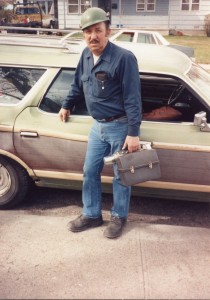
The National Youth Administration officially operated from June 26, 1935 to 1939, and was designed to provide training and help find jobs for people during the Great Depression. It was part of The New Deal programs set up by President Franklin D Roosevelt during his first term in office. I don’t often agree with government run programs, I suppose this one had it’s place. Many of the people who benefitted from the chance to train themselves for a new skill were farmers who didn’t have many other skills, and it was the training my dad received there that supported our family for his entire working life. The National Youth Administration was officially transferred to the War Manpower Commission in 1942, and officially folded in 1943. It was most likely due to lack of funding to continue the program, but I suppose it served a greater purpose during the war years, and now was no longer necessary.
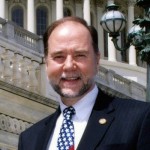 For the past several weeks, I have been exchanging emails and lots of information with a man named John B Knox. He is my husband, Bob Schulenberg’s sixth cousin once removed. I came across his website about a year or so ago, but it wasn’t until recently that I decided to contact him. This was such a great decision on my part, because it has been an interesting journey. Because John had the last name of Knox, and some of the same relatives that I knew to be in the Knox line of my mother-in-law’s family, I had no doubt in my mind that we are related, but I didn’t know the exact relationship. Finding someone who is a descendant of an aunt or uncle back in the 1800s and especially beyond that, isn’t as easy as one might think. It is very helpful when you find someone who has researched their family history as well as John has, because the research is more that half done. It was easy for John to connect our two lines and tell me exactly what the connection was. John is a very thorough person too, so he was able to send me an easy to follow diagram of the connection. Now, my family tree shows the connection to John and his family in detail.
For the past several weeks, I have been exchanging emails and lots of information with a man named John B Knox. He is my husband, Bob Schulenberg’s sixth cousin once removed. I came across his website about a year or so ago, but it wasn’t until recently that I decided to contact him. This was such a great decision on my part, because it has been an interesting journey. Because John had the last name of Knox, and some of the same relatives that I knew to be in the Knox line of my mother-in-law’s family, I had no doubt in my mind that we are related, but I didn’t know the exact relationship. Finding someone who is a descendant of an aunt or uncle back in the 1800s and especially beyond that, isn’t as easy as one might think. It is very helpful when you find someone who has researched their family history as well as John has, because the research is more that half done. It was easy for John to connect our two lines and tell me exactly what the connection was. John is a very thorough person too, so he was able to send me an easy to follow diagram of the connection. Now, my family tree shows the connection to John and his family in detail.
Getting to know John has been a lot of fun. He was born in Kentucky, but he and his family now live in Washington DC. I could try to summarize his career, but I think he says it best so I will quote it instead. According to John’s LinkedIn page, “I currently serve as a Congressional Liaison for the Defense Intelligence Agency (DIA). My background includes two decades+ of experience in management, strategic planning, change management, international business development, customer relations and team building. Highlights include my seven years as NASA’s Manager of Video Applications. The 35-member team that I led, using the world class production facilities that my team designed and built, won 44 awards on behalf of the space agency, including four Emmy’s. That record at NASA remains unmatched. I co-chaired the agency-wide Standards Committee for High Definition Television at NASA which established technical guidelines for the space agency’s transition to HDTV. Today, the guidelines which my group developed, continues to insure the interoperability of communications between each of NASA’s ten world-class research centers and the International Space Station. While serving as the DIA’s Contracting Office Manager in Baghdad, Iraq, I oversaw a “ground-up” conversion of twelve Iraqi buildings for use as DIA’s in-country Headquarters, Annex and billeting for deployed U.S. personnel. For this project, I was awarded DIA’s Civilian Combat Support Award. Most recently, I drafted, proposed and am currently leading the implementation the first Congressional Communications Strategic Plan for DIA. I hold a Bachelor’s Degree in Communications Technology, a Master’s Degree in Media Management (Magna Cum Laude graduate) and a Master Of Business Administration (MBA) Degree with a concentration in management.” All I could say to that was…”Wow!!”
This, of course, lets me know that I really knew nothing of the person, that I had so boldly contacted, and who so graciously contacted me back, and has helped me immensely with my inquiries. I have always known that the Knox family has been heavily into politics, and other areas of government work, and this Knox family member has obviously followed in the footsteps of his ancestors. I can’t say that I’m disappointed in that. I also know that his work at NASA interests me as well. I’m sure he would not have brought all this up to me on his own, because he never made the conversations we had about himself, but rather about the family history, and our connection to it. I think he is probably a humble man, and only put the information I gave here on LinkedIn, because that is what he was supposed to do on LinkedIn. Nevertheless, I must say that I am impressed with all he has done, and excited to know him and to get to know his family as wall. John and his wife Lisa have two daughters, Lindsey and Kelly. I am excited about this new branch of my family history, and I look forward to getting to know this family even better.
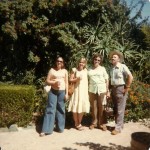
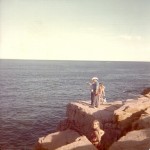 In 1980, my parents and younger sisters took a trip to California. It was a trip that would take them to the famous Golden Gate Bridge, as well as, drives along the Pacific Ocean, and relaxing time spent on the beach. It was the first of a number of trips my parents would take to California. They really loved that area. I would not get to see California until the late 1990s. I’m not sure what took me so long really.
In 1980, my parents and younger sisters took a trip to California. It was a trip that would take them to the famous Golden Gate Bridge, as well as, drives along the Pacific Ocean, and relaxing time spent on the beach. It was the first of a number of trips my parents would take to California. They really loved that area. I would not get to see California until the late 1990s. I’m not sure what took me so long really.
Today is a rather significant day in the history of San Francisco, and one that in reality makes any trip to California worth taking. It was on this day January 5, 1933 that work began on the rather controversial Golden Gate Bridge. I’m sure that most people would not think of the bridge as being controversial, but there were a lot of people who were against it because they thought it would ruin the beautiful view of the San Francisco Bay. I guess I can understand that to a degree, because I am someone who really doesn’t like change much, but when you look at the finished product, I would have to agree with most people when I say that I think this one was a good change. The bridge is a beautiful addition to the bay. I especially like its red color, which I suppose might seem a bit unusual for a bridge. Nevertheless, it does make this bridge stand out.
Still, why was the bridge necessary? When you look at the whole area, you find that you could have driven around the area. Nevertheless, I’m sure that back then, driving around would take too long. The idea was that if the land north of the bay was easier to access, it’s value would increase. It made sense, but while the idea was first presented in 1869, it was pretty much tabled until it was revisited in 1916, when a former engineering student named James Wilkins, who was working for the San Francisco Bulletin brought it up again. He proposed a suspension bridge with a center span of 3,000 feet which was nearly twice as long as any bridge in existence at the time. The expected cost was $100 million, but when the city engineer, Michael O’Shaughnessy, who is also credited for naming the Golden Gate Bridge began to ask around, he found Joseph Strauss, a 5 foot tall Cincinnati born Chicagoan who said he could do it for less. In fact, for $25 – 30 million, Strauss said he could build one with a 4,000 foot span.
The idea was well received, but the Great Depression would stall the construction until 1933 when bonds could be sold to make it happen. The bridge would take four years to complete, and so it first opened on May 27, 1937, as the longest bridge span in the world 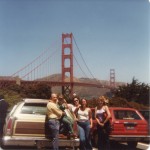
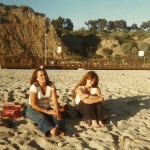 at that time. The first public crossing had taken place the day before, when 200,000 people walked, ran, and even roller skated across the bridge. It’s red paint job and its famous towers have made the Golden Gate Bridge an American landmark and popular tourist attraction ever since, and one that I am glad I got to see. While San Francisco’s temperatures don’t always appeal to me, the summers of which are not always warm, I do nevertheless, love visiting there. Like my parents, I find the California coast to be a pleasant change from the mountains of Wyoming.
at that time. The first public crossing had taken place the day before, when 200,000 people walked, ran, and even roller skated across the bridge. It’s red paint job and its famous towers have made the Golden Gate Bridge an American landmark and popular tourist attraction ever since, and one that I am glad I got to see. While San Francisco’s temperatures don’t always appeal to me, the summers of which are not always warm, I do nevertheless, love visiting there. Like my parents, I find the California coast to be a pleasant change from the mountains of Wyoming.
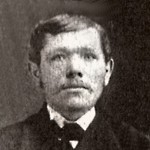 Many people, myself included, believe that our country was founded and populated in an effort to escape religious persecution. Looking back on several branches of my family tree, as well as that of my husband, I see the personal accounts of a number of people who dealt with persecution first hand. People such as my Aunt Bertha Schumacher Hallgren, who makes not of it in her journals when she speaks of her father, my great grandfather, Carl Schumacher’s return trip to Germany to visit family members who were still living there. During that time, the German government was doing it’s very best to force people to deny the very existence of God on any level, and their lack of any need for a god to lean and rely on. So often, I think of religious persecution, such as we have in the United States today, as being a problem of the current times. I suppose that is because it feel very personal to me at this time in history, but in reality, I suppose it is nothing new. In fact, the Bible says that there is no new thing under the sun.
Many people, myself included, believe that our country was founded and populated in an effort to escape religious persecution. Looking back on several branches of my family tree, as well as that of my husband, I see the personal accounts of a number of people who dealt with persecution first hand. People such as my Aunt Bertha Schumacher Hallgren, who makes not of it in her journals when she speaks of her father, my great grandfather, Carl Schumacher’s return trip to Germany to visit family members who were still living there. During that time, the German government was doing it’s very best to force people to deny the very existence of God on any level, and their lack of any need for a god to lean and rely on. So often, I think of religious persecution, such as we have in the United States today, as being a problem of the current times. I suppose that is because it feel very personal to me at this time in history, but in reality, I suppose it is nothing new. In fact, the Bible says that there is no new thing under the sun.
When my great grandfather made the trip back to his homeland, he had plenty of time. His visit was extended for several months. It was most likely during that time that he became more and more convinced that his move to the United States was the right one for him. While he was free, or at least relatively so, to practice his faith  in his own way, there was, nevertheless, a number of incidences whereby doing so could be frowned upon to say the very least. That fact would not be something that would deter my grandfather from standing on his faith, and it would renew his love for his new country, and his reasons for coming here to it.
in his own way, there was, nevertheless, a number of incidences whereby doing so could be frowned upon to say the very least. That fact would not be something that would deter my grandfather from standing on his faith, and it would renew his love for his new country, and his reasons for coming here to it.
I have run across many other ancestors, particularly on the Knox side of the family who suffered persecution from people in their homeland over their choice of religious beliefs. It’s strange to think that when someone receives a revelation concerning God’s word, that they are immediately looked upon as severely brain damaged. Why is it that people would assume that we humans, with our small minds would somehow have the capacity to know everything God intended for us to know…that there couldn’t possibly be anything else for us to learn from His word. And yet, that is exactly what we do. That is why our forefathers left the old world, and came to America in the first place. The churches they were forced to be a part of, or the removal of any kind of religion from their lives had left them with no choice but to leave the country they have called home all their lives, and move to an unknown world.
I don’t know how many immigrants arrived here as a result of religious persecution, but I do know that our nation has somehow lost sight of why we first began to exist. There are so many religions in the world today…especially Christians and Jews who are bring brutally persecuted right now. I still believe in freedom of religion. I may not agree with some of the religions in the world, but each person should have the right to believe as they choose. And no one should ever have to pay for their beliefs with their lives. I know that this world will probably not change that until Jesus returns, and I think that is very sad.
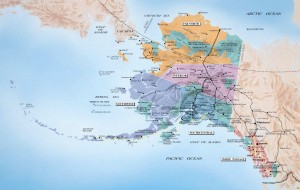 Until recently, I had never given much thought to historic events concerning Alaska. It wasn’t that I wasn’t interested, but rather that other places occupied my mind. Nevertheless, with the recent trip Bob and I took, Alaska has found a place in my mind and heart. Does that mean I have the Alaska Bug…well maybe, because if you offered me a free trip, I would be there with bells on. That said, I noticed the fact that today is a hugely significant day in Alaska’s history. Alaska became a state on December 7, 1959, the 50th state, Hawaii joined the union on August 21, 1959. It is very strange to think that it took almost 172 years to acquire all 50 states, and the final two joined within my lifetime. In our minds, we rather expect that all the states would have been within the first hundred years of each other, but such was not the case at all. Nevertheless, all but two states were within the first 125 years, with only the last two joining 47 years later.
Until recently, I had never given much thought to historic events concerning Alaska. It wasn’t that I wasn’t interested, but rather that other places occupied my mind. Nevertheless, with the recent trip Bob and I took, Alaska has found a place in my mind and heart. Does that mean I have the Alaska Bug…well maybe, because if you offered me a free trip, I would be there with bells on. That said, I noticed the fact that today is a hugely significant day in Alaska’s history. Alaska became a state on December 7, 1959, the 50th state, Hawaii joined the union on August 21, 1959. It is very strange to think that it took almost 172 years to acquire all 50 states, and the final two joined within my lifetime. In our minds, we rather expect that all the states would have been within the first hundred years of each other, but such was not the case at all. Nevertheless, all but two states were within the first 125 years, with only the last two joining 47 years later.
Alaska was first discovered in 1741 when a Russian expedition led by a Danish navigator named Vitus Bering sighted the Alaskan mainland. Before long Russian hunters were making trips into Alaska, and their presence wreaked havoc on the Aleutian people, who had been relatively disease free prior to their exposure to foreign diseases. The first permanent Russian colony in Alaska was established on Kodiak Island in 1784 by Grigory Sheliknov. Settlements spread across the west coast of North America during the 19th century, with the southernmost fort located near Bodega Bay in California. By the 1820’s, the Russians were spending less and less time in the new world, and the British and Americans were allowed to trade in Alaska…after a few diplomatic conflicts. By the 1860s, Russia was nearly bankrupt, and so they decided to offer Alaska for sale to the United States, because they had expressed an interest earlier. The purchase took place on March 30, 1867 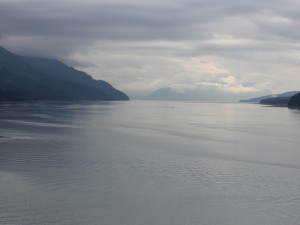 when Secretary of State William H Seward…I wondered where some of the names came from…signed the agreement and the United States purchased Alaska for 7.2 million…which was about two cents an acre…quite a deal really. Nevertheless, the purchase was ridiculed by Congress and the place was called “Seward’s Folly”, “Seward’s Icebox”, and President Andrew Johnson’s “polar bear garden” for some time. Still, the Senate ratified the purchase of this vast land that measured one fifth of the size of the continental United States.
when Secretary of State William H Seward…I wondered where some of the names came from…signed the agreement and the United States purchased Alaska for 7.2 million…which was about two cents an acre…quite a deal really. Nevertheless, the purchase was ridiculed by Congress and the place was called “Seward’s Folly”, “Seward’s Icebox”, and President Andrew Johnson’s “polar bear garden” for some time. Still, the Senate ratified the purchase of this vast land that measured one fifth of the size of the continental United States.
Settlement of the new territory was very slow. It seemed that people didn’t feel comfortable about this cold, desolate wilderness, where the sun didn’t act like it did in the rest of their world. Nevertheless, all their apprehension was quickly forgotten with the discovery of gold in 1898. People moved to Alaska in droves to try to make their fortune. In my travels to Alaska, I had the opportunity to watch a movie about the Klondike Gold Rush. While people did find gold, it came at a heavy price, and many people paid the ultimate price. This land was an unforgiving place. Those who were not prepared for it’s harshness, soon found out what it took to live there, and not everyone could do so. It didn’t make them less manly, it just wasn’t for everyone…gold or no gold.
Still, those people who came to Alaska and felt an instant connection, knew in their hearts that this harsh, vast wilderness had somehow gotten into their blood. That is how Alaskans feel about their state to this day. Not everyone is cut out for it, and they do have a tendency to laugh and joke a bit about the light weights who go home, but they also understand that the ones who stay are a bit of a rare breed. In years gone by, we would have called them Mountain Men, and I suppose that fits the early Alaskan people, but by the same token, they would not have made it either, had it not been for the wisdom of the Aleutian people concerning their health. There weren’t all kinds of things like antibiotics, and immune system boosters then. And fruits and such were not plentiful either. But the Aleutian people knew of ways to get vitamin C and other things to prevent disease.  Even so, at that time, people did not stay permanently in Alaska. They summered there. Many people still do. They just don’t like the winters there. And yet, if you look, there are areas of Alaska…along the coast, like Anchorage that is actually warmer than places like Chicago. Of course, the interior just doesn’t fall into the warm category, with temperatures reported as low as -65° is some places. I think I might want to get out of there for the winter too. Nevertheless, Alaska is an amazing state, and one that I would love to visit again. Not only is it big in size, but everything there seems huge. The mountains are amazing, and the glaciers awe inspiring. If you ever get the chance to visit our 49th state, it is a trip you will never forget…believe me.
Even so, at that time, people did not stay permanently in Alaska. They summered there. Many people still do. They just don’t like the winters there. And yet, if you look, there are areas of Alaska…along the coast, like Anchorage that is actually warmer than places like Chicago. Of course, the interior just doesn’t fall into the warm category, with temperatures reported as low as -65° is some places. I think I might want to get out of there for the winter too. Nevertheless, Alaska is an amazing state, and one that I would love to visit again. Not only is it big in size, but everything there seems huge. The mountains are amazing, and the glaciers awe inspiring. If you ever get the chance to visit our 49th state, it is a trip you will never forget…believe me.
 Every day, we benefit from safety measures that have been put in place as a result of a need, or more often a tragedy, that occurred in the past. We give very little thought to things like fire drills, earthquake drills, or even the fire extinguisher on the wall in buildings. We don’t normally think about the fire exit, unless we are looking for the way out of a building and find that this exit is only to be used in case of a fire. I suppose that the reason we don’t think of these things is that we expect the place we are in to be a safe place. There are regulations surrounding the public use of buildings that require that the building meet a certain standard of safety, and most often they do…these days anyway.
Every day, we benefit from safety measures that have been put in place as a result of a need, or more often a tragedy, that occurred in the past. We give very little thought to things like fire drills, earthquake drills, or even the fire extinguisher on the wall in buildings. We don’t normally think about the fire exit, unless we are looking for the way out of a building and find that this exit is only to be used in case of a fire. I suppose that the reason we don’t think of these things is that we expect the place we are in to be a safe place. There are regulations surrounding the public use of buildings that require that the building meet a certain standard of safety, and most often they do…these days anyway.
These safety lessons were not so pleasant to learn for those who came before us and who didn’t survive. Such was the case on December 30, 1903, when the Iroquois Theater in Chicago caught fire and killed 602 people, 572 inside the theater, with the rest dying of the injuries received in the fire. That total included 212 children. You see, the Iroquois Theater was hosting hundreds of adults and school children to a Holiday performance of a play starring the popular comedian, Eddie Foy. The sad thing is that the theater was thought to be fireproof. In reality it was a deathtrap, due to so many safety violations. As a result, the lives of many families were devastated. As I looked at the list of victims, I can’t say that I ran across any I knew to belong in my family tree, but I could be wrong on that too. My family and that of my husband, Bob, spent a lot of time in the Great 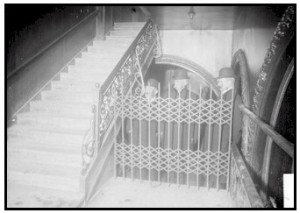 Lakes area, so it is entirely possible that my own family lost people due to this tragedy as well.
Lakes area, so it is entirely possible that my own family lost people due to this tragedy as well.
These days, our children think nothing of a fire alarm going off in school. They have several of them a year. when the alarm goes off, they simply follow their training and line up to leave the building. If there were a fire, they would most likely not know it until they were not allowed to go back into the building. Children in earthquake prone areas at taught exactly what to do if the room starts shaking, and they respond automatically, often saving their lives.
The problem with the Iroquois Theater fire, was as simple as the problem with the Titanic. People didn’t think the building could possible burn, or the ship sink. The Iroquois Theater was only open five weeks before it’s total destruction. As a result, lives were lost. In my reading of this tragedy, I found that while the architect wanted every possible safety measure taken, costs had been cut and therefore, the fireproof theater everyone thought they were in, simply did not exist. The theater was over crowded by 400 people, at 2,000 people in a theater designed to hold 1,600. They stairway to the fire escape hadn’t been finished yet. exit doors had been designed to be pulled open, and with the crowd of fear stricken people, the press was to much, and the escape, completely blocked. Iron gates closing off some of the stairways were locked, and people tried jumping out the window…to their deaths unfortunately. In some 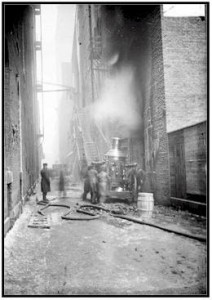 places the bodies were stacked 10 high with people attempting to crawl over each other to get out. In desperation the fire department set up a bridge of sorts to get people out. Some got out, some didn’t.
places the bodies were stacked 10 high with people attempting to crawl over each other to get out. In desperation the fire department set up a bridge of sorts to get people out. Some got out, some didn’t.
I don’t know why we humans always seem to think that something we build could be indestructible, when in reality, much of what we build is, in one way or another, flawed. I think that one of the best things we can do for our families, is to make sure they all know how to get out of a building safely. We can hope that the architect, contractor, workers, and inspectors all did their job properly, but we must remember that they are only human too, and mistakes can be made. If people know not to panic, they can get out safely more times than not, but panic…most often results in tragedy. And that is what happened in the Iroquois Theater in Chicago on December 30, 1903…panic and a complete disregard for the elementary rules of safety.
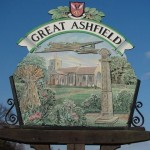
 When I talked to my dad about his time at Great Ashfield in Suffolk, England, we talked about, among other things, the sign at the town entrance that still stands today, after all these years since the end of World War II. The picture of the B-17G Bomber flying low over the town is not something that would necessarily be well received these days, when people are so quick to complain about the planes when they live near an airport. I understand why people would not like planes flying low on takeoffs and landings these days, but the planes that fly over my house really don’t bother me at all. Nevertheless, my dad assured me that the people of Great Ashfield felt anything but irritation at the low flying planes that graced their skies during World War II.
When I talked to my dad about his time at Great Ashfield in Suffolk, England, we talked about, among other things, the sign at the town entrance that still stands today, after all these years since the end of World War II. The picture of the B-17G Bomber flying low over the town is not something that would necessarily be well received these days, when people are so quick to complain about the planes when they live near an airport. I understand why people would not like planes flying low on takeoffs and landings these days, but the planes that fly over my house really don’t bother me at all. Nevertheless, my dad assured me that the people of Great Ashfield felt anything but irritation at the low flying planes that graced their skies during World War II.
England was among the nations who had taken some serious hits by the Nazi war machine in the early days of World War II, prior to the entrance of the United States into the war. In fact, it was on this day, December 29, 1940 that London took a massive hit during a German raid. The German planes had been targeting London since August of 1940 as payback for the British attacks on Berlin. In September the Germans dropped 337 tons of bombs on docks, tenements, and the streets in one of London’s poorest districts. Then came December 29, 1940. The attack on that day produced widespread destruction of not just civilians, but also many of London’s cultural relics. The bombing was relentless and as a result, 15,000 separate fires were started. Historic buildings were severely damaged or destroyed. Among them, the Guildhall, which was an administrative center of the city 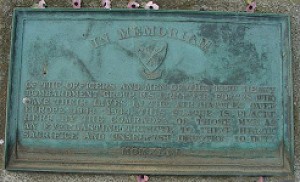 that dated back to 1673, but contained a 15th century vault. Eight Christopher Wren churches were also damaged or destroyed. St Paul’s Cathedral caught fire, but was saved by the firefighters who risked their own lives to save it. Westminster Abbey, Buckingham Palace and the Chamber of the House of Commons were also hit, but the damage to these was less severe. These attacks, that went on from September of 1940 through May of 1940, were known as the London Blitz, and they killed thousands of civilians.
that dated back to 1673, but contained a 15th century vault. Eight Christopher Wren churches were also damaged or destroyed. St Paul’s Cathedral caught fire, but was saved by the firefighters who risked their own lives to save it. Westminster Abbey, Buckingham Palace and the Chamber of the House of Commons were also hit, but the damage to these was less severe. These attacks, that went on from September of 1940 through May of 1940, were known as the London Blitz, and they killed thousands of civilians.
It wasn’t until Pearl Harbor was attacked on December 7, 1941, that the United States entered World War II, and soon after came the time that my dad spent at Great Ashfield beginning in early April of 1944 until he went home in October of 1945. While it may have seemed to many that we were somewhat late coming to the party, the war torn nations around the world were happy to see us arrive. It wasn’t that we were going to be the heroes riding in on the white horses, but we meant instant reinforcements to nations that needed assistance badly. The airmen were well received in the towns surrounding Great Ashfield, and the other air bases in England, but it was Great Ashfield that felt such gratitude that they went to the length of making and leaving to this day, the sign showing the B-17G Bomber flying low over the local church. There is also another memorial honoring the men of the 8th Air Force and the 385th Heavy Bombardment Group.
The reasons for the warm feelings toward the 8th Air Force and the 385th Heavy Bombardment Group are obvious. It was so much more than just the reinforcements the United States provided. While talking to my 
 dad about this, he revealed that the main reason that they were so grateful is that the safest times for the area were when the B-17G Bombers were flying overhead. The German aircraft would become really scarce when the Bombers were around, because they didn’t want to be shot down either. The constant activity surrounding the air field made it almost impossible for the Germans to attack the area. Bombings are horrible, and take a huge toll on the civilians, as well as buildings. I suppose I would be eternally grateful for those planes, those men, and the United States 8th Air Force too. It gave peace of mind.
dad about this, he revealed that the main reason that they were so grateful is that the safest times for the area were when the B-17G Bombers were flying overhead. The German aircraft would become really scarce when the Bombers were around, because they didn’t want to be shot down either. The constant activity surrounding the air field made it almost impossible for the Germans to attack the area. Bombings are horrible, and take a huge toll on the civilians, as well as buildings. I suppose I would be eternally grateful for those planes, those men, and the United States 8th Air Force too. It gave peace of mind.
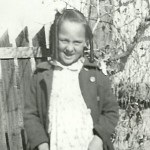 My husband, Bob’s Aunt Esther is the half sister of his dad, Walt Schulenberg. Times were different when Esther was a little girl, and children who lived in the country in northern states often stayed with families that lived in town during the winter because getting to school from the farm wasn’t always easy. Such was the case with Esther, and the family she stayed with was her older brother’s family, my future in-laws, Walt and Joann Schulenberg. Walt and Joann hadn’t been married very long, but they took on the challenge of a school aged child to help out the family.
My husband, Bob’s Aunt Esther is the half sister of his dad, Walt Schulenberg. Times were different when Esther was a little girl, and children who lived in the country in northern states often stayed with families that lived in town during the winter because getting to school from the farm wasn’t always easy. Such was the case with Esther, and the family she stayed with was her older brother’s family, my future in-laws, Walt and Joann Schulenberg. Walt and Joann hadn’t been married very long, but they took on the challenge of a school aged child to help out the family.
I’m sure that as with any child, my mother-in-law found the challenge of a school aged sister-in-law a little problematic at times. She once said to me, “Don’t Esther!!”, when she was frustrated that I was making her go to bed, after Alzheimer’s Disease had made it necessary to help her with these daily tasks. She doesn’t very often mistake me for someone else, but I must say that on that occasion, it was pretty funny to be mistaken for Esther, and from way back when she was getting in trouble for horsing around or some other such mischief. I told Esther, that it was nice to have someone else get the blame for once.
Esther told me once that she had always considered my father-in-law, Walt to be a second dad to her. I suppose that would be true considering that she lived with them. Esther looked up to both her brother and her sister-in-law, and often called them to visit or ask for advise. It was quite hard on her when my father-in-law was very ill, and my mother-in-law was diagnosed with Alzheimer’s Disease. I’m sure it felt like she was losing her parents all over again. I can relate to that, since they have been my second parents for the past 39 years. You grow close, and you don’t think that you will ever lose them…until you do. With her older brother gone now, Esther has felt a loneliness that probably will never go away…and I hate that, because she always had such a sweet smile and delightful laugh, and it hurts to know that she is sad.
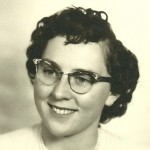
My first encounter with Esther was shortly after Bob and I were married. Bob had asked me to cut his hair, and I had never cut a man’s hair before. Needless to say, it was horrible, and our wedding was just a couple of days away. When I met Esther, the haircut was still fresh on our minds, and after telling the story, she laughed about the whole thing and offered to teach me how to cut it correctly. What a lifesaver that was. I have been cutting Bob’s hair ever since, and every time I do, I think of Esther, and how she taught me to cut it. I think I do a pretty good job these days, and Bob must too, because he continues to let me get near him with the hair trimming scissors. Today is Esther’s birthday. Happy birthday Esther!! Have a great day!! We love you!!
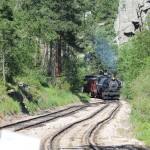 I read an article in the Casper Star Tribune yesterday that made me think about the many changes in the railroad over the years. When my grandfather, Allen Luther Spencer was working on the railroad as a carpenter during World War II, and for years before that, it took a number of people to run a train. The freight trains during World War II typically had seven people aboard…an engineer, conductor, up to four brakemen and a fireman. With all the trains that were running…not nearly as many as we have today…the railroad supplied a lot of jobs. This was just to run the actual train. The maintenance personnel, the station managers, and others who were required to keep the trains running smoothly, added to the number of people it took to ultimately move the trains along the tracks at any given moment. The trains of that era weren’t anywhere near as long as they are these days either.
I read an article in the Casper Star Tribune yesterday that made me think about the many changes in the railroad over the years. When my grandfather, Allen Luther Spencer was working on the railroad as a carpenter during World War II, and for years before that, it took a number of people to run a train. The freight trains during World War II typically had seven people aboard…an engineer, conductor, up to four brakemen and a fireman. With all the trains that were running…not nearly as many as we have today…the railroad supplied a lot of jobs. This was just to run the actual train. The maintenance personnel, the station managers, and others who were required to keep the trains running smoothly, added to the number of people it took to ultimately move the trains along the tracks at any given moment. The trains of that era weren’t anywhere near as long as they are these days either.
As technology became more sophisticated, fewer people were needed to run a train, and by the 1970s, the number of people on a freight train had dropped to five people, and by 1991, only the engineer and the 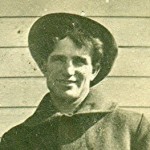 conductor were needed to run the train. When you consider that the trains have become so long that it can take twenty minutes to get the whole train through a crossing, that seems amazing to me. I guess it is amazing to a lot of other people too, because as the railroads are trying to eliminate one of those positions as well, a lot of people are quite worried about the safety of the trains. What strikes me as funny, however, is that the concern is that if they need to disconnect a car so emergency vehicles can get through, the engineer can’t leave his post to do so. I’m sure that in the future that part will be handled too, because technology is getting to the point whereby the train really could be run without a driver, just like the model trains are.
conductor were needed to run the train. When you consider that the trains have become so long that it can take twenty minutes to get the whole train through a crossing, that seems amazing to me. I guess it is amazing to a lot of other people too, because as the railroads are trying to eliminate one of those positions as well, a lot of people are quite worried about the safety of the trains. What strikes me as funny, however, is that the concern is that if they need to disconnect a car so emergency vehicles can get through, the engineer can’t leave his post to do so. I’m sure that in the future that part will be handled too, because technology is getting to the point whereby the train really could be run without a driver, just like the model trains are.
Much like the model trains, there is a controller at a central location who can see all the trains for his area. In reality, they probably could control the train with no one on it, but how strange that would be…especially when talking about passenger trains. But then, with subways, and airport trains, we often get on the train, and never see if anyone is running it. In airports, the voice telling you of your arrival is even 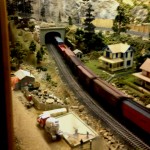 mechanical. I have to wonder if anyone is running those, and maybe someone out there will clarify that one for me. Someday, or even already, we will probably ride trains and never give a second thought to the fact that there is no engineer. Everything has become so technical, and we have reached a point of being so used to robotics, that we don’t even give a second thought to the aspect of someone being in control of this massive train we have just boarded…and people have said that flying is like being in a cattle truck. Turning control of our lives to someone we don’t know, or even to a robot, seems very strange, even today, but what would the people of my grandfather’s era have thought about having no one to run the train. I’m quite sure they would never have boarded at all.
mechanical. I have to wonder if anyone is running those, and maybe someone out there will clarify that one for me. Someday, or even already, we will probably ride trains and never give a second thought to the fact that there is no engineer. Everything has become so technical, and we have reached a point of being so used to robotics, that we don’t even give a second thought to the aspect of someone being in control of this massive train we have just boarded…and people have said that flying is like being in a cattle truck. Turning control of our lives to someone we don’t know, or even to a robot, seems very strange, even today, but what would the people of my grandfather’s era have thought about having no one to run the train. I’m quite sure they would never have boarded at all.
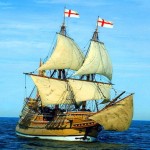 Thanksgiving Day is behind us for this year, of course, but today is a day that ties into Thanksgiving in a big way. On September 16, 1620, the Mayflower left Plymouth, England on its way to the New World. I can’t begin to imagine how so many of our ancestors must have felt at that time. It was going to be a long voyage, and some of them might not make it to the end of the trip, but going was worth the risk. There were 102 passengers on the 90 foot ship. The ship was bound for Virginia, where the colonists half of whom were religious dissenters and half of whom were entrepreneurs, and all of whom had been authorized to settle in the New World by the British crown. The trip was difficult, with rough seas and storms that blew the ship 500 miles off course. When they landed, it was in Massachusetts and not Virginia that the colonists found themselves, and I guess they were not bound by the exact location, because no one was there to tell them that they had to move. So they settled there.
Thanksgiving Day is behind us for this year, of course, but today is a day that ties into Thanksgiving in a big way. On September 16, 1620, the Mayflower left Plymouth, England on its way to the New World. I can’t begin to imagine how so many of our ancestors must have felt at that time. It was going to be a long voyage, and some of them might not make it to the end of the trip, but going was worth the risk. There were 102 passengers on the 90 foot ship. The ship was bound for Virginia, where the colonists half of whom were religious dissenters and half of whom were entrepreneurs, and all of whom had been authorized to settle in the New World by the British crown. The trip was difficult, with rough seas and storms that blew the ship 500 miles off course. When they landed, it was in Massachusetts and not Virginia that the colonists found themselves, and I guess they were not bound by the exact location, because no one was there to tell them that they had to move. So they settled there.
I did not recognize anyone on the passenger list that I specifically knew to be related to me, but there were numerous sir names that I have seen in my own family history. In researching the genealogy of the people from the Mayflower however, I find that we are related to some of them because, some of the people that we know that we are related to are related to some of them. An expedition of men was sent out to scout the land, and the ship remained anchored at the tip of Cape Cod in what is now Provincetown harbor in present day Provincetown, Massachusetts. While the men were out scouting for a suitable place to build a town, Susanna White, a passenger on the ship, gave birth to her second child, a son named Peregrine. He was the first English child born in New England.
The expedition found a suitable place to settle, with cleared fields and plentiful water. They returned to the ship and the ship was moved to what is now Plymouth Harbor, arriving on December 21st. Two days later, on December 23, 1620, construction began on the settlement that was to be named Plymouth…this day 394 years ago. The first year was really difficult, with half of the people dying of disease. It was a difficult time for the colonists. It wasn’t until 1621 that the health of the people improved…as did the economic condition, with a great harvest.
To celebrate, the governor, William Bradford invited neighboring Indians to Plymouth to celebrate the bounty of the year’s harvest, in what would become the first Thanksgiving Day celebration. The people secured peace treaties with the Indians, and soon more people were attracted to the settlement of Plymouth. By the 1640s the population was over 3,000, but was nevertheless, overshadowed by the larger population of the 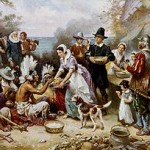 Massachusetts Bay Colony that was started by Puritans in 1629.
Massachusetts Bay Colony that was started by Puritans in 1629.
Nevertheless, it would be the Plymouth colony who would have the honor of hosting the first Thanksgiving, and the honor of being know as the first Pilgrims. The name pilgrim did not come into being until the early 19th century and it was from a manuscript written by Govern Bradford in which he spoke of the “saints” who traveled to the New World as “pilgrimes” in 1620. Orator Daniel Webster spoke of the “Pilgrim Fathers” at a bicentennial celebration of Plymouths founding. The name pilgrim stuck and they have been know as such in history ever since. So, while Thanksgiving is past, believe it or not, its beginning actually happened on December 23, 1620, almost a year before the actual event took place.

